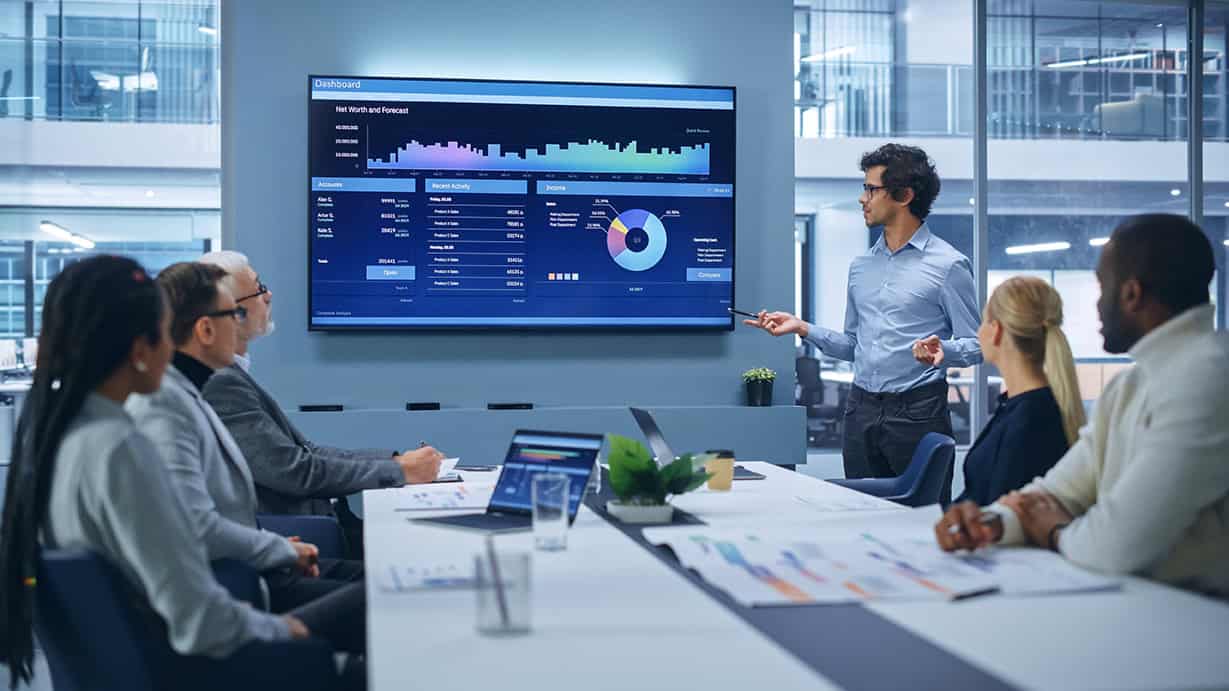
Fluctuating trade regulations and increasing penalties for non-compliance are making global trade more difficult and costly to manage. However, with the right technology, companies can navigate these challenges and even achieve significant cost savings and competitive advantages. The benefits of Global Trade Management (GTM) software are many. Companies can use it to automate international trade management processes to mitigate risks, ensure global trade compliance, and minimize the costs of international business in a volatile world economy.
Companies employing a GTM solution can achieve millions of dollars in duty savings, avoid customs delays and fines, protect their corporate reputation, and gain a competitive advantage, especially when integrating global trade with end-to-end supply chain operations.
What is Global Trade Management Software?
Global Trade Management software automates regulatory trade compliance, duty management, customs documentation, and customs filings for products shipped and sold across borders. The core components of an end-to-end trade compliance software solution include due diligence screening, customs document preparation and filing, duty management, and regulatory trade content. These core components can be used in import and export processes.
Trade Regulation Content
Complete, up-to-date information about trade regulations and rules—regulatory trade content —is a foundation for effective trade management and compliance, whether a company is exporting, importing, or both. Regulatory trade content ranges from the customs tariffs used to classify goods to the duty rates needed to calculate landed costs and the export control rules determining whether a company can legally complete a transaction.
Collecting, cleansing, and publishing trade content is a challenging process, complicated by the number of countries and government agencies involved, differences in trade regimes, various formats, and rapidly changing regulations. Maintaining accurate trade content is essential for efficient, effective trade compliance processes.
Due Diligence Screening
Governments worldwide publish hundreds of frequently updated lists of persons, organizations, and entities blocked from transacting in certain jurisdictions. Manually determining if a partner, customer, or contact is designated as a restricted party is time-consuming, inefficient, and unreliable. Transacting with these parties, even unintentionally, can result in steep penalties and corporate risk.
Due diligence screening applications—also referred to as restricted party screening or denied party screening—provide companies with a reliable way to thoroughly screen parties, commodities, and destinations against hundreds of government lists to protect businesses from economic and reputational risk.
Customs Documentation and Filings
Customs filing software applications automate the preparation and filing of customs documents, allowing companies to confidently prepare and file accurate and complete customs declarations in a timely manner supported by advanced automation and research capabilities.
Without this technology, companies have two options for preparing and filing trade documentation: develop and self-file your customs declarations or outsource the process to a customs broker firm. Self-filing tends to be a complex, manual procedure, and using a broker increases your expenses and risk of noncompliance — especially when trading across multiple countries. Customs filing applications solve these problems by giving companies an affordable, accurate tool that automates and streamlines customs declarations and filings.
Duty Management
Leveraging Free Trade Agreements (FTAs), duty drawbacks, and duty deferral programs is a great way to reduce or eliminate import costs. But qualifying products for each relevant FTA and managing the filing process requires expert knowledge most companies don’t have in-house.
To use FTAs, importers must solicit product information from supply chain partners and determine which products conform to the rules of origin for each trade agreement. Similarly, customs warehouses and free-trade zones (FTZ) help importers defer or reclaim their duty payments. Still, the programs are challenging to administer manually, and outsourcing can quickly outweigh the potential financial benefits. A duty management software, such as e2open’s Duty Management application, can address these challenges and help companies optimize the benefits of all relevant duty reduction programs.
What are the top 6 benefits of Global Trade Management Software?
Global Trade Management software (GTM) helps companies navigate the complex challenges of global trade and identify potential duty cost savings to improve margins and grow revenue. When global trade processes are aligned and integrated with supplier management, procurement, logistics, and other supply chain processes, the benefits of GTM solutions are magnified even further.
1. Reduced risk
GTM software helps companies avoid fines and minimize reputational risk by creating accurate, efficient trade processes backed by comprehensive regulatory trade content.
2. Enhanced compliance
Trade management solutions help ensure compliance with ever-changing rules and regulations by accessing up-to-date regulatory data and information and automating restricted party screening, document creation, duty management, and filings.
3. Duty cost savings
GTM applications optimize duty savings by identifying all relevant duty, tax, and tariff reduction programs and automating the management of deferrals and refunds. Fully leverage EU Customs Warehousing, U.S. Foreign Trade Zones (FTZs), and duty drawback programs, among others. Some companies can slash duty costs by half with GTM software.
4. Reduced border delays
Global trade management software solutions help companies speed up imports and exports by avoiding filing errors or omissions, electronically filing complete, accurate customs documentation, and enabling collaboration with suppliers, brokers, carriers, and freight forwarders.
5. Improved efficiency in trade operations
GTM software creates repeatable trade processes, automates document creation and filings, and frees up trade operations staff to focus on higher-value activities where their expertise is needed.
6. Competitive advantage and expansion opportunities
Companies using Global Trade Management software can increase margins by reducing duty and tariff costs. In addition, duty and tariff data can be used to identify new market opportunities and to optimize future duty savings when making sourcing and manufacturing plans.
What are the top 5 leading challenges in Global Trade Management in 2023?
The complexities and challenges of international trade management have increased steadily over the past decade as governments around the world use trade policies and regulations in new ways. This has led to increased volatility in trade, imposing new risks and rising costs on global companies.
1. Ever-changing trade regulatory landscape
Trade regulations are changing more frequently as governments enact new rules to support economic goals and political objectives ranging from forced labor to sustainability and conflict minerals. Interpreting complex, ever-changing regulations is difficult, and the risks of non-compliance are increasing as governments apply new enforcement standards.
2. Increasing demands for up- and down-stream traceability
Advanced economies have enacted new rules requiring greater visibility into suppliers and buyers. More products are restricted for export, and imports of some products are subject to strict new supplier traceability requirements. To comply, companies need to collaborate with multiple tiers of suppliers, increasing the burden on trade management teams.
3. Rising costs of global trade
Fees, duties, and taxes are increasing, and many products are subject to new tariffs, all of which increase product costs. In addition, the costs to administer trade operations are rising due to the greater complexity and volatility of trade rules.
4. Expensive and error-prone processes
Manual trade management processes are inherently expensive and error-prone, especially in the face of complex and changing rules and regulations.
5. Lack of visibility and collaboration with supply chain partners
Trade processes are often siloed from other supply chain processes, inhibiting visibility and collaboration with suppliers, logistics providers, customs brokers, carriers, etc. This increases costs and compliance risks.
What are the four best practices for Global Trade Management?
By implementing the following international trade management best practices, companies can improve efficiency, consistency, and accuracy, improve collaboration, and reduce trade compliance risk. These best practices apply whether your organization centralizes trade management or decentralizes trade operations within business units or geographically. Industry-leading trade management software solutions are instrumental in realizing these process improvements.
1. Enforce standard processes to maintain compliance across the globe
It is crucial that trade compliance staff use standard, repeatable processes that can be centrally audited and managed. GTM software helps ensure consistency by embedding industry best practices and business rules for each territory in which a company operates.
2. Connect GTM within your end-to-end supply chain to break down silos and improve visibility
Accurate, efficient customs filings often require data and information from suppliers and other trading partners. Likewise, global trade processes are closely linked to logistics, both for international and domestic transportation. Companies should integrate their global trade processes and technology with supply management, transportation, and logistics systems to improve visibility and coordination.
3. Ensure access to accurate, current regulatory data
Most organizations work with outside providers for trade content, as they don’t have the internal resources to monitor regulatory changes across the globe. When looking at content providers, it is equally important that changes in regulatory laws and other global trade data can be quickly and easily applied within your standard trade processes.
4. Use intelligent automation to improve accuracy and efficiency
Automation can streamline repetitive trade tasks, reduce errors, and save time and costs. Artificial intelligence (AI) is also useful in several global trade tasks, including due diligence screening, product classifications, and identifying duty reduction opportunities.
Transform your global trade management with e2open
The e2open Global Trade application suite helps companies gain the agility to respond rapidly to unpredictable regulatory environments, maintain compliance, reduce duty costs, and manage trade risks.
Part of the e2open connected supply chain platform, the suite is used to efficiently plan, execute and administer global trade, backed by the world’s most comprehensive database of regulations and business rules, covering 98% of world trade. The software automatically applies these regulatory rules to all cross-border transactions, mitigating non-compliance risks such as border clearance delays, fines, loss of trade privileges, and criminal liability. Organizations also gain the ability to minimize duty costs and speed up imports and exports by accessing the connections in e2open’s powerful network of global trade partners.
E2open delivers everything companies need to efficiently manage global trade on a single platform.
Sign up for our weekly Global Trade Newsletter to receive the latest regulatory updates, trade-related news, and information in your email box.
Are you interested in learning more? Contact us for a demo or to speak with one of our global trade experts.







